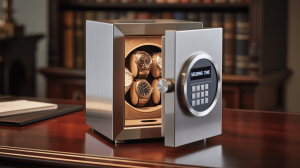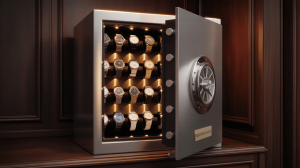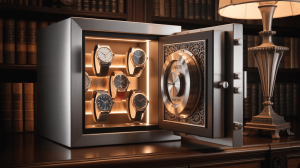How to Choose the Perfect Safe for Watches. But here’s the kicker… Your cherished timepieces deserve more than a drawer—they need specialized safes that combine top‑tier security, optimal climate control, and elegant design to preserve both function and value.
1. Assess Your Security Needs
First, evaluate your neighborhood crime rate and home security. A UL RSC burglary rating or ETL equivalent ensures the safe can withstand forced entry for a specified duration. Consider lock options—mechanical dials never fail without power, electronic keypads offer multiple user codes, and biometric scanners grant instant access. Plan anchoring: bolting to floor or wall studs prevents thieves from simply walking away with the safe. Prioritize features based on risk level—urban dwellers may need higher ratings, while low‑crime areas could suffice with basic certified models.
| Security Feature | Function | Benefit |
|---|---|---|
| UL RSC Burglary Rating | Certified break‑in resistance | Proven deterrence |
| Lock Type | Mechanical, electronic, biometric | Tailored access control |
| Anchor Points | Bolt to structure | Prevents safe removal |
2. Determine Fire and Heat Resistance
Fires can engulf a home in minutes. Look for UL 72 ratings—30 minutes at 1,200 °F or up to 120 minutes at higher temperatures. Insulation materials like gypsum or ceramic composites block heat transfer, keeping internal temps below 350 °F and protecting lubricants inside your watches. Intumescent gaskets expand under heat to seal gaps against smoke and flames. Balance fire protection with safe size—longer ratings often increase weight and bulk.
3. Measure Space and Capacity
List all watches plus extras—straps, tools, warranty cards—and plan for future additions. Measure pillow height (1.5–2 inches), then internal depth accordingly. Ensure the safe’s external dimensions (including hinges and clearance) fit your chosen location: closet niche, desk shelf, or custom cabinet. A snug fit boosts concealment and security, whereas wasted space can compromise stability and aesthetics.
4. Choose the Right Materials
Safe exteriors typically use 12‑ to 14‑gauge steel for robust protection. Composite fireboards line interiors for insulation. Look for corrosion‑resistant powder‑coat finishes or stainless steel hardware in humid environments. Luxury models add wood veneers or leather wraps for décor integration. Material selection influences durability, fire performance, and visual appeal.
| Material | Durability | Aesthetic |
|---|---|---|
| 12‑Gauge Steel | High physical protection | Industrial or painted finish |
| Composite Fireboard | Fire insulation | N/A |
| Wood Veneer/Leather | Scratch resistant surface | Premium, custom look |
5. Select Interior Organization
Effective organization prevents scratches and makes rotation effortless. Use foam or velvet‑lined watch pillows sized to your case diameter. Adjustable trays allow reconfiguration for larger or smaller watches. Removable winder modules convert winding bays into storage when not in use. Hidden pockets under trays store straps, spring bars, or cleaning tools—keeping accessories close yet out of sight.
6. Evaluate Watch Winder Integration
If you own automatics, integrated winders save manual winding. Ensure winder modules offer customizable Turns‑Per‑Day (TPD) and rotation direction (clockwise, counterclockwise, or bi‑directional). Quiet motors under 25 dB avoid noise pollution. Pause intervals prevent over‑winding. Removable trays let you switch between winding and static storage.
7. Check Climate and Humidity Controls
Moisture can corrode metal parts and degrade leather straps. Look for sealed gaskets rated IP54 or higher to block dust and light water. Desiccant chambers or silica gel packs maintain humidity below 50%. Premium safes include digital hygrometers to monitor moisture in real time. Some incorporate active dehumidifiers for precise control in variable climates.
| Climate Feature | Function | Benefit |
|---|---|---|
| IP54 Door Seals | Dust and splash protection | Keeps internals clean |
| Desiccant Chambers | Passive moisture absorption | Preserves metal and leather |
| Digital Hygrometer | Monitors humidity | Informed environmental control |
8. Prioritize Ease of Access
Quick, reliable access matters. Electronic keypads allow multiple unique codes; biometric scanners store several fingerprints; mechanical dials never rely on batteries. Time‑delay settings slow forced entry attempts. Backup override keys or mechanical access ensure entry during power failures. Interior LED lighting activates on open, illuminating your collection.
9. Consider Noise and Vibration
Winder motors and locking bolts can generate sound. Choose models with rubber‑dampened mounts and silent hinge designs. Motors rated under 25 dB run quietly in bedrooms or offices. Test decibel levels in specs or reviews to avoid disruptive humming or clicking sounds.
10. Review Smart and Connectivity Features
Smart safes connect via Bluetooth or Wi‑Fi to send tamper, door‑open, and low‑battery alerts directly to your smartphone. Apps allow remote lock/unlock, rotation setting adjustments, and digital audit trails of every access. These features add convenience and real‑time security updates whether you’re home or away.
| Smart Feature | Functionality | Advantage |
|---|---|---|
| Tamper Alerts | Instant notifications | Immediate security awareness |
| Remote Control | Mobile lock/unlock | Convenience |
| Audit Logs | Records access attempts | Track user entry |
11. Examine Power and Backup Systems
Electronic and biometric safes need power continuity. Seek dual‑power support—AC adapter for daily operation and rechargeable battery packs for backup. Low‑battery warnings or app alerts prevent unexpected shutdowns. Manual override keys or mechanical dials act as failsafes, ensuring you never lose access.
12. Match Style and Décor
Safes no longer must look industrial. Select finishes—matte black, satin white, wood veneer, or leather wrap—to blend with interiors. Slim profiles and rounded corners suit modern furniture. Custom engraving or color‑matched panels personalize your safe as a décor element as much as a security device.
| Style Option | Visual Impact | Integration |
|---|---|---|
| Matte Black | Modern minimalist | Versatile |
| Wood Veneer | Warm elegance | Matches cabinetry |
| Leather Wrap | Rich texture | Complements décor |
13. Balance Budget and Value
Price ranges vary widely: entry‑level safes ($100–$300) cover basic security; mid‑tier models ($300–$700) add fire ratings and electronic locks; premium units ($700+) feature smart connectivity, luxury finishes, and extended warranties. Prioritize must‑have features—certifications and interior layout—before optional extras like décor or IoT.
14. Verify Warranty and Support
A robust warranty reflects manufacturer confidence. Look for 2–5 year coverage on both safe and winder components. Onsite service options, spare part availability, and responsive customer support simplify repairs. Read reviews concerning service responsiveness and ease of claims.
| Warranty Aspect | Duration | Benefit |
|---|---|---|
| Standard Warranty | 1–3 years | Basic coverage |
| Extended Coverage | 5+ years | Long‑term peace of mind |
| Support Services | Phone/Onsite | Quick issue resolution |
15. Final Decision Checklist
Compile your requirements—security ratings, fire performance, interior needs, access methods, style, smart features, and budget—into a priority list. Compare certified models against this checklist to find the perfect match. Consult user reviews, professional tests, and manufacturer specs before purchasing.
Conclusion
Balancing security, climate control, and aesthetics ensures your watches remain safe, functional, and displayed with pride. Ready for the good part? Use this comprehensive guide to choose the perfect watch safe that blends protection with style—because preserving your collection starts here.
FAQ
Q1: What fire rating is sufficient?
Aim for UL 72 Class 350—30 minutes at 1,200 °F or higher.
Q2: Do biometric locks require power?
Yes, but always include a mechanical override key.
Q3: How often replace desiccant packs?
Every 6–12 months, depending on humidity levels.
Q4: Are smart features secure?
Use encrypted connections and strong passwords to protect remote access.
Q5: Is professional installation necessary?
DIY anchoring works if you follow instructions; stud or concrete mounting is best for security.







